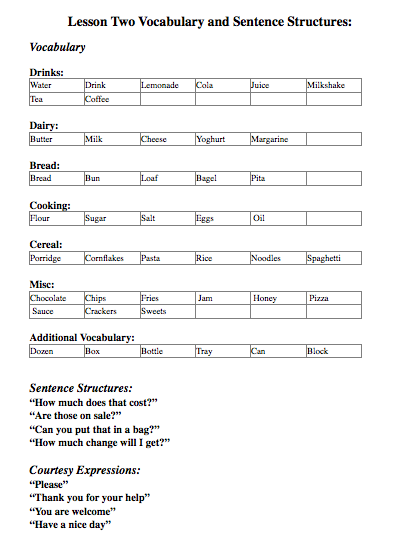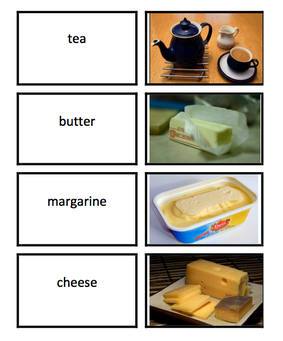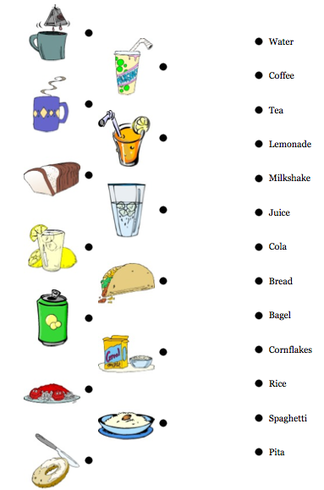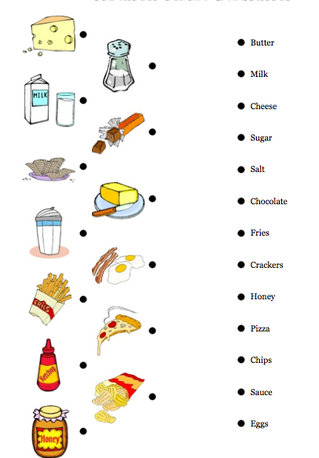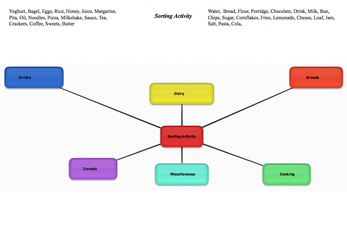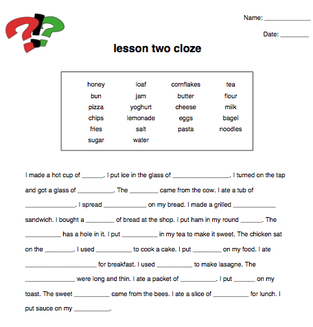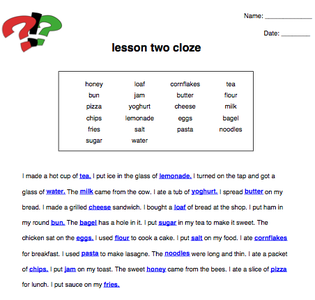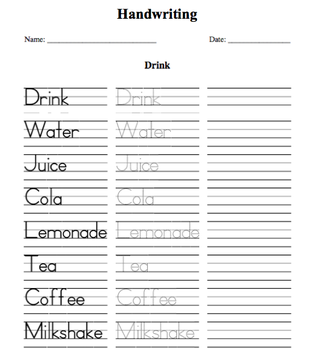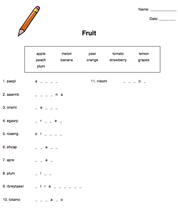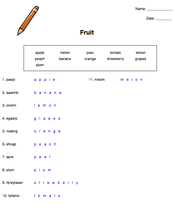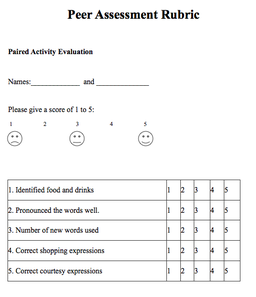Lesson Two
|
Learning Intention: Students will identify and name objects found when food shopping and will also be able to understand and learn appropriate shopping expressions and courtesy phrases. Students will demonstrate developing knowledge of vocabulary and sentence structures through a reflective journal. |
WALT (We Are Learning To):
1. Identify basic drinks and other food stuffs in English.
2. Use shopping expressions correctly in English.
3. Use courtesy expressions correctly in English.
4. Monitor our own progress in this unit by recording reflections and evaluations in an on-going journal.
Success Criteria:
We will know we have achieved this when:
1. We have learnt 20 new shopping related words.
2. We are able to use 4 new sentence structures based on shopping expressions.
3. We are able to use 2 new sentence structures based on courtesy expressions.
4. We have recorded reflective journal entries and scores in our journal as indicated during each lesson.
Learning Journal
(i) Students head up Lesson Two sub heading in learning journal. Teacher model and write on board for students to copy.
(ii) Students record WALT and Success Criteria under Lesson Two.
Vocabulary
|
Vocabulary and Sentence Structures The following are the vocabulary and sentence structures used in this lesson: |
http://www.familylobby.com/common/tt6115628fltt.gif Students glue a print out of vocabulary for Lesson Two into Learning Journal.
Review
Each student has either a food picture card or word card. They walk, skip or dance around the room, when the music stops they have to find their partner. Leave students with word and picture cards, or give them printable cards and they can play a matching game in pairs or as a class.
Extension Activity: Visit the following website for a variety of picture match activities based around food vocabulary: manythings.org
Activity One
Each student has either a food picture card or word card. They walk, skip or dance around the room, when the music stops they have to find their partner. ( revision of vocabulary learnt in lesson 1 through word/ picture matching.) If online, they could play an interactive matching game –if we find one. Leave students with word and picture cards or give them printable cards and they can play a matching game in pairs or as a class.
Full list of picture cards here: File:Vocabsheet2.pdf
Activity Two
In pairs, students practice one or two expressions of their choice. After about five minutes they come back and role play to the class. Teacher may ask for feedback about each performance from peers.
Activity Three
Task i
Matching Activity
File:Wordmatch1.pdf File:Wordmatch2.pdf
Task ii
Sorting Activity
Students use vocabulary given and categorise under the relevant bubble.
Task iii
Cloze Activity
Task iv
Audio File Activity
Students listen through audio file once. Repeat audio file and practice vocabulary whist file is playing. This may be repeated several times as necessary. Students may do this in pairs and support each other providing feedback on pronunciation.
Task v
Handwriting practice
Students complete the handwriting practice sheets below:
File:Writingdrink.pdf File:Writingdairybread.pdf File:Writingcookingcereals.pdf File:Writingmiscfoods.pdf
http://www.familylobby.com/common/tt6115628fltt.gif Students glue completed worksheets from above tasks into Learning Journal.
Reflection
Task i
Poster Activity. Students are given a big sheet of paper and they draw a grid on the paper with at least 44 squares on the paper. In each square they write the vocabulary word and draw a corresponding picture. They then stick the paper on a large piece of cardboard or thicker paper. They then cut the cards up so each student has a set of picture cards. They then play a matching game with their partner or they test their partner on the vocabulary cards.
http://www.familylobby.com/common/tt6115628fltt.gif Students glue poster or reduced copy of poster into Learning Journal. Their partner completes an evaluation on this poster (using tool such as PMI: Plus, Minus, Interesting).
Task ii
Pronunciation: Students identify and pronounce a new word they have learnt. In pairs or small groups, students take turns in identifying a new word they have learnt. Students pronounce new word and other students support and give feedback. All students have a turn at pronouncing one or more new words.
Assessment
Learning Journal
Conduct a vocabulary test the same as lesson one.
Formative
Ongoing teacher formative assessment of students. Teacher questions and reviews student progress providing formative feedback for individuals. Formative activities should be conducted across a range of whole class, group and individual activities regularly throughout the lesson. Feedback may be written or oral and may or may not be recorded for future reference as deemed appropriate by the teacher.
http://www.familylobby.com/common/tt6115628fltt.gif Teacher can make formative assessment comments in Learning Journal where and as appropriate.
Written
Word scramble activity for capable students to challenge learning and demonstrate developing ability in vocabulary structure (spelling application)
Word Scramble
File:Fruitscramble.pdf File:Vegescramble.pdf File:Meatscramble.pdf File:Adjectivesscramble.pdf '
http://www.familylobby.com/common/tt6115628fltt.gif Add completed and marked Word Scramble to Learning Journal.
Rubric
Marking group/individual activities using a rubric to assess completion of tasks.
http://www.familylobby.com/common/tt6115628fltt.gif Students glue completed Peer Assessment into Learning Journal.
